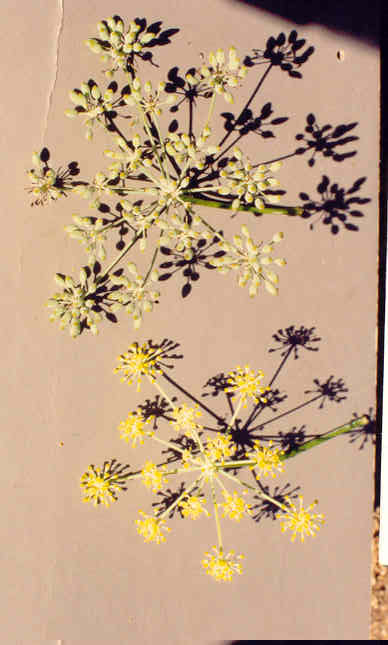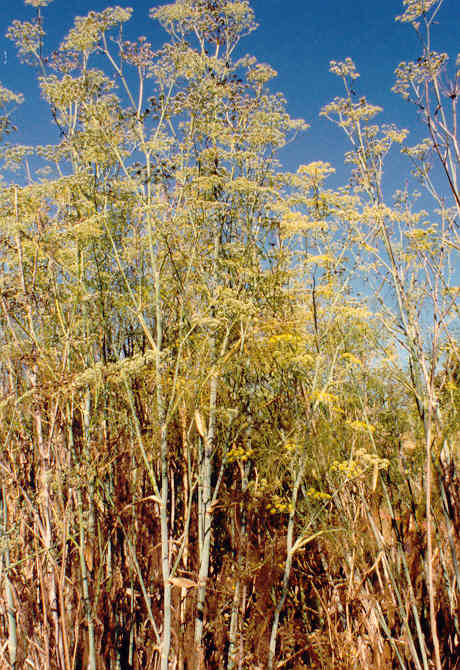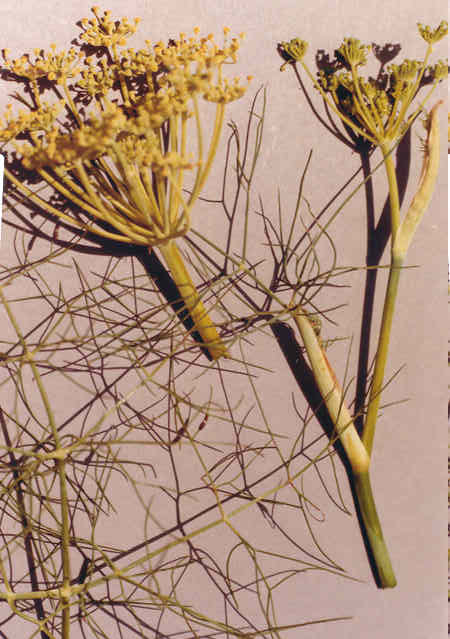
Foeniculum vulgare Mill.
= Foeniculum vulgare var. vulgare
Apiaceae (Carrot Family)
Europe
 |
Foeniculum vulgare Mill.= Foeniculum vulgare var. vulgareApiaceae (Carrot Family)Europe
Sweet FennelSweet Anise |
August Photo
Plant Characteristics:
Erect perennial herb, with anise odor, 1-2 m. high, with striate
branching stems, glaucous; lf.-blades ovate to deltoid in outline, to ca. 3 dm.
long, pinnately decompound into filiform divisions 4-10 mm. long; petioles
broadly sheathing; fls. yellow, in large compound umbels; rays 15-40 +/-
unequal, 1-6 cm. long; fr. oblong, 3.5-4 mm. long, the ribs acute; oil tubes
solitary in the intervals.
Habitat: Common in waste
places especially in s. and cent. Calif. May-Sept.
Name:
Latin, foenum, hay, because of
the odor. (Munz, Flora
So. Calif. 76). Vulgare
means that it is common. (Dale 47).
General:
Very common in the study area. Photos
from the Santa Ana Heights area. (my comments).
It is reported that in Spanish days, Sweet Fennel was spread on the
mission floors to give a pleasant scent when bruised by the feet of the
congregation. True licorice comes
from the root of Glycyrrhiza glabra, a
member of the pea family. (Dale
47). Ancient
Egyptians, Hindus and Chinese used fennel seeds for spices.
The Romans, then as now cultivated it for its seeds and edible shoots.
The fragrant fronds were made into garlands with which to crown
victorious warriors. The young
stems before they flower, when still tender, are cooked like celery, much of the
anise flavor being dissipated in the cooking.
Tea can be made by steeping Fennel leaves in hot water. (Clarke 150). Fennel
flowers and leaves together will make a yellow dye.
(lecture by Charlotte Clarke, author of Useful and Edible Plants of California, April 1987).
True anise is genus Pimpinella. (ref. not
recorded). Common
fennel, Foeniculum vulgare, yielded a
volatile oil prepared from the dried ripe fruit as a stimulant of fairly good
flavor. (Fielder 213).
If one wanted to modify the action of purgatives, it was said that dried
ripe fruit of fennel, F. vulgare,
would serve the purpose, and volatile oil prepared from fennel would also act
against gas on the stomach. (Fielder
104). Fennel, F. vulgare and coriander, Coriandrum
sativum, were both added to other medicines as a flavoring agent.
(Fielder 226). Delfina Cuero, a Kumeyaay or
Southern Diegueno Indian, made the following comments about Foeniculum
vulgare in her autobiography: "We
boiled the seeds to drink the liquid as a tea for stomach aches."
(Shipek 90).
Fennel seeds are used in black bread, rolls, pastries, sauerkraut, sweet
pickles, soups, roast pork, sauces, fish, etc.
Certain spices prevent food's edible fats from turning rancid according
to scientists of India. Previously
it has been assumed that spices were added to foods to cover up the rancidity or
decay. They report that Cumin, Caraway or Fennel seeds, Cinnamon,
Nutmeg, Cloves, Pepper and red Chilies are among the spices that will preserve
fats even under very severe oxidation tests.
The following is taken from Phillips "Kitchen Garden", printed
in 1831: "French epicures keep their fish in Fennel herb to make them firm.
In France the herb is used in all fish soups".
An old recipe to relieve
hiccoughs advises chewing Fennel or Anise seed, and swallowing the juice.
(Meyer 182, 187, 208).
An
excellent remedy for small children. For
colic, the herb should be steeped and given in small doses every half-hour until
the infant or child is relieved. (Kloss
239).
Text Ref:
Hickman, Ed. 148; Munz, Calif.
Flora 1016; Munz, Flora So. Calif.
76; Roberts 7.
Photo Ref:
June 6 83 # 4,5; July-Sept 96 # 18,19.
Identity: by R. De Ruff.
First Found: June 1983.
Computer Ref: Plant Data 140.
No plant specimen.
Last edit 10/12/04.
 |
 |
August Photo June Photo